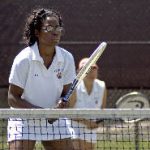Women in Sports
- Why Emphasize Sports for Girls and Women?
- The Success of Women’s Sports
- Women’s Sports in Washington
Why Emphasize Sports for Girls and Women?
 As the only independent college for women in Washington, D.C., Trinity has a special care and concern for issues that affect women and their families. As educators specializing in the needs of women and adolescent girls, Trinity’s faculty and staff know that there is a vital link between academic success, and emotional and physical well-being. Many studies show that active engagement in sports and fitness programs clearly provides both physical and psychological benefits that support academic achievement as well.
As the only independent college for women in Washington, D.C., Trinity has a special care and concern for issues that affect women and their families. As educators specializing in the needs of women and adolescent girls, Trinity’s faculty and staff know that there is a vital link between academic success, and emotional and physical well-being. Many studies show that active engagement in sports and fitness programs clearly provides both physical and psychological benefits that support academic achievement as well.
In developing the Trinity Center for Women and Girls in Sports, Trinity has received active encouragement and support from the Women’s Sports Foundation, the organization through which scores of female Olympians and championship athletes create educational and support programs for other women and girls. The Women’s Sports Foundation has conducted extensive research on the link between academic success and sports for women and girls. Their research indicates that:
- Girls who participate in sports are less likely to get involved with drugs, less likely to become pregnant and more likely to graduate from high school than those who do not play sports. (Women’s Sports Foundation Study, 1989)
- Women who are student athletes graduate at significantly higher rates (69%) than women students generally (58%). (NCAA News, 1995)
- Half of all girls who participate in some kind of sports experience higher than average levels of self-esteem and less depression. (Colton & Gore, Risk, Resiliency, and Resistance: Current Research on Adolescent Girls, Ms. Foundation, 1991)
- 80% of women identified as key leaders in Fortune 500 companies participated in sports during their childhood. (Bunker, L.K., Lifelong Benefits of Youth Sport Participation for Women and Girls, Sport Psychology Conference at UVA, 1988)
- Women who are active in sports and recreational activities as girls feel greater confidence, self-esteem and pride in their physical and social selves than those who were sedentary as kids. (Miller Lite Report, 1985)
- In older women, weight-bearing exercise can reduce the risk of osteoporosis, currently affecting one of out of four women over age 60 with an $18 billion annual cost. (National Institutes of Health Research)
- African American women are under represented in the general ranks of female athletes, except in basketball and track & field. (Opportunities for Minority Women in Sport: The Impact of Title IX. JOPERD 63(3), 56-59)
The Success of Women’s Sports
 The recent success of the women’s sports movement underscores the importance of this research. In the 1990s, a quarter of a century after Title IX mandated equal opportunity for women in school-based sports and educational programs, competitive women’s sports had become a public phenomenon, as evidenced by the dominance of women during recent Olympic Games, the popularity of the Women’s National Basketball Association, the Women’s World Cup soccer games and development of the WUSA women’s professional soccer league. Women’s intercollegiate sports are growing in size and scope; today’s high school girls are inspired by watching the Connecticut Lady Huskies or the Tennessee Lady Vols compete on national television in the women’s NCAA Final Four, a post-Title IX phenomenon that clearly puts a national spotlight on the importance of women’s sports at the major universities.
The recent success of the women’s sports movement underscores the importance of this research. In the 1990s, a quarter of a century after Title IX mandated equal opportunity for women in school-based sports and educational programs, competitive women’s sports had become a public phenomenon, as evidenced by the dominance of women during recent Olympic Games, the popularity of the Women’s National Basketball Association, the Women’s World Cup soccer games and development of the WUSA women’s professional soccer league. Women’s intercollegiate sports are growing in size and scope; today’s high school girls are inspired by watching the Connecticut Lady Huskies or the Tennessee Lady Vols compete on national television in the women’s NCAA Final Four, a post-Title IX phenomenon that clearly puts a national spotlight on the importance of women’s sports at the major universities.
Outside of school settings, while opportunities for girls and women to participate in organized sports and recreational opportunities remain limited, there is a growing interest in adult women’s teams and athletic activities ranging from soccer and hockey to rock climbing and kayaking. Programs for older women, whether competitive running or water aerobics, promote the benefits of lifelong physical fitness activities. Yet, in spite of a quarter of a century of progress for women’s athletic endeavors, facilities to support women’s sports and physical fitness remain limited.
Women’s Sports in Washington
 In the Washington area, while hundreds of millions of dollars have supported the development of large commercial stadia and arenas that largely support men’s professional sports (with the exception of the Mystics WNBA team and the occasional figure skating or gymnastics competition), the development of community-based and neighborhood recreational centers has languished, especially in the District of Columbia. Children and youth in the neighborhoods like Trinity’s Edgewood/Brookland community have very few structured recreational sports programs to attend after school, on weekends and in the summer. Adult women have even fewer options.
In the Washington area, while hundreds of millions of dollars have supported the development of large commercial stadia and arenas that largely support men’s professional sports (with the exception of the Mystics WNBA team and the occasional figure skating or gymnastics competition), the development of community-based and neighborhood recreational centers has languished, especially in the District of Columbia. Children and youth in the neighborhoods like Trinity’s Edgewood/Brookland community have very few structured recreational sports programs to attend after school, on weekends and in the summer. Adult women have even fewer options.
Aware of these local needs, and aware of its own institutional need to build a campus center with indoor athletic and recreational facilities, Trinity determined that the most appropriate campus development project would incorporate the community need into the campus design in order to achieve the maximum possible use from the facility. Hence, Trinity intends to create the Center for Women and Girls in Sports as a facility that will house structured educational, athletic and recreational programs for Trinity students, for schoolchildren (boys and girls), for community groups, and, in a special way, for adolescent girls and women of all ages.